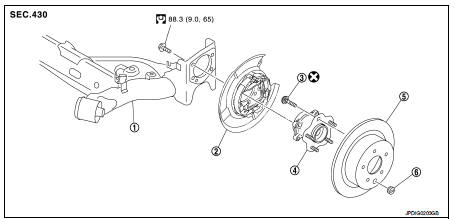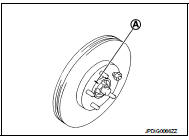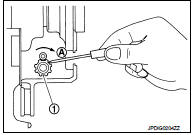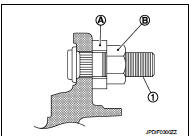Nissan Juke Service and Repair Manual : Removal and installation
REAR WHEEL HUB
Exploded View

1. Rear suspension beam
2. Rear brake assembly
3. Hub bolt
4. Wheel hub assembly (Bearing-integrated
type)
5. Disc rotor
6. Plug
 : Always replace after every
: Always replace after every
disassembly.
 : N·m (kg-m, ft-lb)
: N·m (kg-m, ft-lb)
Removal and Installation
REMOVAL
1. Remove tires. Refer to WT-7, "Removal and Installation".
2. Remove wheel sensor. Refer to BRC-86, "REAR WHEEL SENSOR : Removal and Installation" (Without ESP), BRC-227, "REAR WHEEL SENSOR : Removal and Installation" (With ESP).
3. Remove caliper assembly. Hang caliper assembly in a place where it will not interfere with work. Refer to BR-65, "BRAKE CALIPER ASSEMBLY : Removal and Installation" (LHD), BR-131, "BRAKE CALIPER ASSEMBLY : Removal and Installation" (RHD).
CAUTION:
Never depress brake pedal while brake caliper is removed.
4. Remove disc rotor. If disc rotor cannot be removed, remove as follows.
CAUTION:
• Parking brake completely in the released position.
• Put matching marks (A) on the wheel hub assembly and the disc rotor before removing the disc rotor.
• Never drop disc rotor.
a. Fix the disc rotor with wheel nuts and remove the adjusting hole plug.

b. Using suitable tool, rotate adjuster (1) in the direction (A) to retract and loosen brake shoe.
5. Remove wheel hub assembly.
6. Remove hub bolts from wheel hub assembly, using a press.
CAUTION:
• Remove hub bolt only when necessary.
• Never hammer the hub bolt to avoid impact to the wheel hub assembly.
• Pull out the hub bolt in a direction perpendicular to the wheel hub assembly.

7. Perform inspection after removal. Refer to RAX-6, "Inspection".
INSTALLATION
Note the following, and install in the reverse order of removal.
• Place a washer (A) as shown in the figure to install the hub bolts (1) by using the tightening force of the nut (B).
CAUTION:
• Check that there is no clearance between wheel hub assembly
and hub bolt.
• Never reuse hub bolt.
• Align the matching marks that have been made during removal when reusing the disc rotor.
• Perform inspection after installation. Refer to RAX-6, "Inspection".

Inspection
INSPECTION AFTER REMOVAL
Check the wheel hub assembly for wear, cracks, and damage. Replace if necessary.
INSPECTION AFTER INSTALLATION
1. Check wheel sensor harness for proper connection. BRC-85, "REAR WHEEL SENSOR : Exploded View" (Without ESP), BRC-225, "REAR WHEEL SENSOR : Exploded View" (With ESP).
2. Adjust parking brake operation (stroke). Refer to PB-2, "Inspection and Adjustment".
3. Check wheel alignment. Refer to RSU-20, "Inspection".
 Periodic maintenance
Periodic maintenance
REAR WHEEL HUB
Inspection
COMPONENT PART
Check the mounting conditions (looseness, back lash) of each component and
component conditions (wear,
damage) are normal.
WHEEL HUB ASSEMBLY (BEARING ...
 Service data and specifications (SDS)
Service data and specifications (SDS)
Wheel Bearing
...
Other materials:
Both side headlamps (LO) are not turned on
Description
Both side headlamps (LO) are not turned ON in any condition.
Diagnosis Procedure
1.CHECK COMBINATION SWITCH
Check the combination switch. Refer to BCS-92, "Symptom Table".
Is the inspection result normal?
YES >> GO TO 2.
NO >> Repair or replace the malfun ...
Precaution
Precautions for Suspension
• When installing rubber bushings, the final tightening must be carried out
under unladen conditions with tires
on ground. Spilled oil might shorten the life of rubber bushings. Be sure to
wipe off any spilled oil.
- Unladen conditions mean that fuel, engine coolant ...
Hazard function
Component Function Check
1.CHECK FUNCTION
1. Select “INTELLIGENT KEY” of “BCM” using CONSULT-III.
2. Select “FLASHER” in “ACTIVE TEST” mode.
3. Check that the function operates normally according to the following
conditions.
Is the inspection result normal?
YES >> Hazard warning lamp ...
